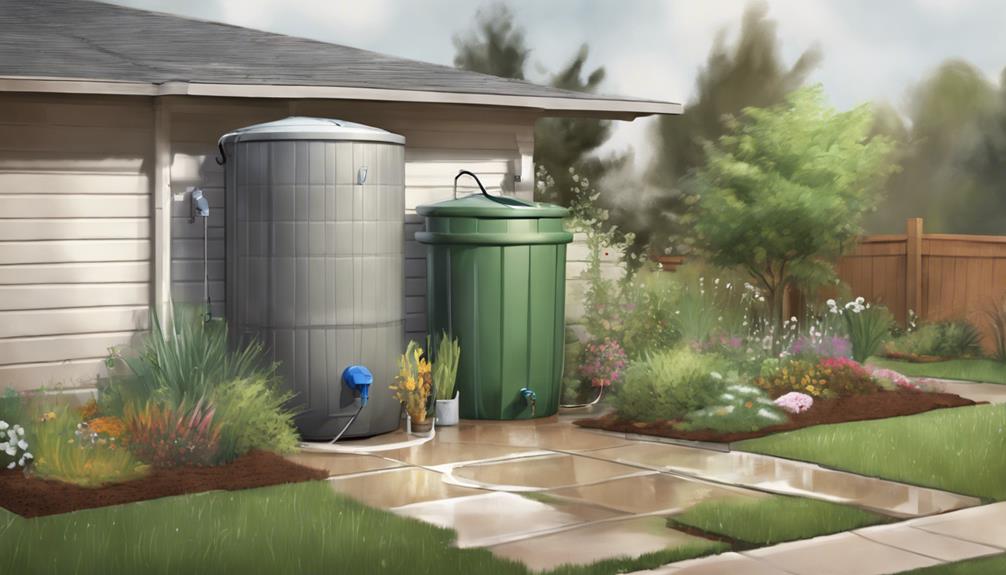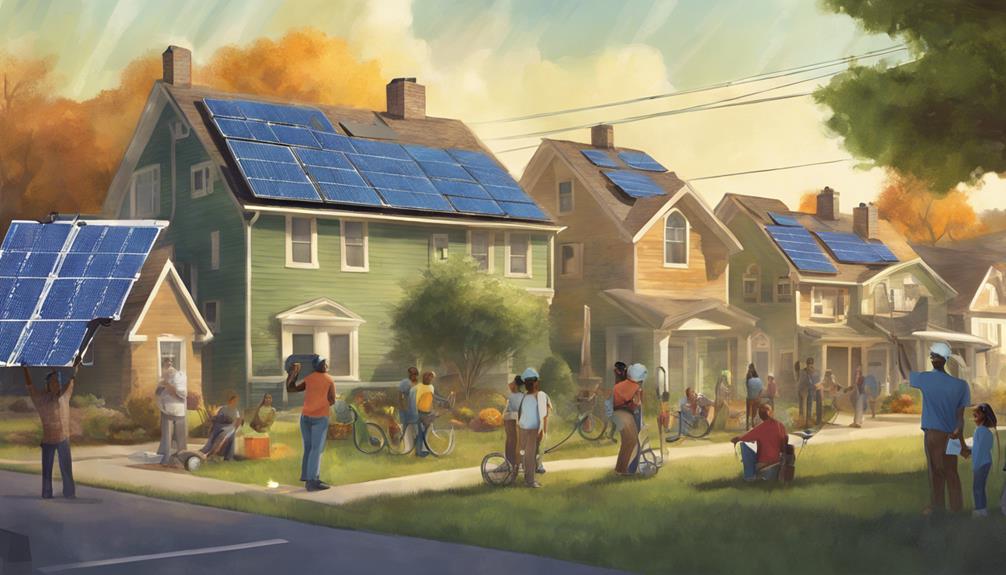Switch to LED bulbs to save up to $75 yearly. Use eco-friendly commuting like carpooling or public transport. Cut waste with composting and recycling, saving resources. Install low-flow fixtures and fix leaks to save water. Eco-shop with minimal packaging and support local businesses. Try composting for rich soil and less waste. Save up to $1,560 yearly with energy-efficient homes. Get involved in community clean-ups and green initiatives. Go paperless and declutter for digital sustainability. Learn how small changes can lead to big green energy savings.
Key Takeaways
- Switching to LED bulbs can save up to $75 annually.
- Walking, biking, or carpooling reduce transportation costs and emissions.
- Composting reduces waste and creates nutrient-rich soil.
- Fixing leaks and using low-flow fixtures save water and money.
- Participating in local clean-up events fosters community engagement and reduces pollution.
Energy-Efficient Lighting Solutions

By switching to LED light bulbs, you can greatly reduce your energy consumption and save money on electricity bills. LED bulbs use 75% less energy and last 25 times longer than incandescent bulbs.
Swapping just 5 bulbs with LEDs can save up to $75 annually on energy costs, leading to significant cost savings in the long run. In fact, widespread use of LED bulbs could save over $30 billion on energy costs by 2027.
Immediate replacement of incandescent bulbs with LEDs not only benefits your wallet but also the environment. Replacing all bulbs in your household with LEDs is equivalent to removing millions of cars from the road regarding energy savings.
Making the switch to LED light bulbs is a simple yet effective way to contribute to energy conservation efforts and enjoy substantial long-term savings on your electricity bills.
Sustainable Transportation Alternatives

You can make a significant impact on the environment by choosing eco-friendly commuting options and embracing efficient travel choices.
Walking, biking, carpooling, using public transit, or switching to electric vehicles are all sustainable transportation alternatives that can help reduce greenhouse gas emissions and lower fuel costs.
Eco-Friendly Commuting Options
Consider incorporating eco-friendly commuting options into your daily routine for cost savings and environmental benefits. Opting for public transportation is one of the most cost-effective ways to reduce energy consumption during your daily commute.
By carpooling with just one other person, you can cut carbon emissions in half compared to driving alone, contributing to a greener environment while saving money.
Biking to work instead of driving not only helps reduce greenhouse gas emissions but also saves around $800 annually on fuel costs.
Additionally, telecommuting one day a week can significantly decrease your carbon footprint by up to 20%.
For those considering a vehicle upgrade, electric vehicles offer substantial savings of about $1,500 per year on fuel costs when compared to traditional gas-powered cars.
Embracing these eco-friendly commuting options not only benefits your wallet but also the planet.
Efficient Travel Choices
Opt for sustainable transportation alternatives to reduce your carbon footprint and contribute to a cleaner environment. Making conscious choices like walking, biking, or utilizing public transportation can notably decrease greenhouse gas emissions. Carpooling with others not only helps lower fuel costs but also reduces traffic congestion. Consider switching to electric or hybrid vehicles for a more eco-friendly option that substantially cuts down on emissions compared to traditional gasoline cars.
To highlight the benefits of sustainable transportation alternatives, here is a table showcasing the positive impacts of various options:
| Sustainable Transportation Alternatives | Benefits |
|---|---|
| Walking, Biking, Public Transportation | Reduce carbon emissions by several tons annually |
| Carpooling | Lower fuel costs and decrease traffic congestion |
| Electric Vehicles | Noticeably reduce greenhouse gas emissions |
Waste Reduction Strategies

Implementing effective waste reduction strategies is vital for minimizing environmental impact and promoting sustainability in green energy initiatives.
To reduce waste, opt for sustainable living practices like composting food scraps to decrease methane emissions from landfills, a potent greenhouse gas. Additionally, choosing products with minimal packaging not only reduces waste but also supports sustainability efforts. By bringing reusable bags and containers, you can prevent the use of hundreds of single-use plastic items annually, further contributing to waste reduction.
Recycling also plays an important role in waste reduction. For instance, recycling one aluminum can save enough energy to power a TV for 3 hours. Furthermore, each ton of recycled paper saves 17 trees, 380 gallons of oil, and 7,000 gallons of water.
These small changes in your daily habits can have a significant positive impact on the environment and help in creating a more sustainable future.
Water Conservation Techniques

To enhance sustainability in your green energy practices, adopting water conservation techniques is essential for reducing water usage and promoting efficient resource management. Fixing leaks and using low-flow fixtures can decrease water consumption by up to 30%.
Consider collecting rainwater for outdoor use, which can save up to 1,300 gallons annually. Running your dishwasher only when it's full could conserve around 100 gallons of water each month.
When tending to your garden, opt for efficient watering practices like watering plants in the early morning or late evening to reduce evaporation and enhance water absorption. Installing low-flow showerheads could save up to 2,700 gallons of water per year for a family of four.
Eco-Friendly Shopping Practices

Consider integrating eco-conscious shopping practices into your lifestyle to support sustainability and decrease environmental impact.
When you shop, choose products with minimal packaging to reduce waste and advocate for sustainability.
Backing local and eco-conscious businesses is a fantastic way to contribute to a more environmentally friendly economy while also nurturing community growth.
Seek out organic and fair-trade labels when purchasing items to guarantee that your choices are environmentally aware and ethically sourced.
Remember to bring your own reusable water bottle and coffee cup to lessen single-use plastic waste and decrease your carbon footprint.
Furthermore, contemplate purchasing pre-owned or vintage items to endorse sustainable fashion practices and diminish the environmental impact of fast fashion.
Green Gardening Tips

When it comes to green gardening, planting native species in your garden not only benefits local wildlife but also supports biodiversity.
Additionally, composting yard waste can help create nutrient-rich soil for healthier plants.
These simple practices can make a big impact on your garden's health and sustainability.
Native Plant Benefits
Adapting to the local climate and soil, native plants require less water and maintenance, making them ideal choices for sustainable gardening practices. When you choose native plants for your garden, you aren't only creating a beautiful landscape but also contributing to the health of the ecosystem.
Here are some key benefits of incorporating native plants into your gardening:
- Water Conservation: Native plants are naturally suited to local conditions, reducing the need for excessive watering and helping conserve water resources.
- Biodiversity: By providing food and habitat for local wildlife, native plants promote biodiversity in the ecosystem, creating a balanced and thriving environment.
- Soil Quality: Using native plants in landscaping can improve soil quality, enhancing its fertility and structure while reducing erosion.
- Ecosystem Health: Native plants help reduce the need for chemical pesticides and fertilizers, contributing to a healthier environment for all living organisms.
Composting for Soil
To enrich your soil and promote sustainable gardening practices, composting organic waste is a cost-effective and eco-friendly solution. Composting not only enhances soil quality by providing essential nutrients for plant growth but also plays a significant role in reducing greenhouse gas emissions.
By diverting approximately 30% of household waste from landfills, composting helps prevent organic waste from producing methane, a potent greenhouse gas. Through the composting process, you can divert up to 700 pounds of organic waste annually, contributing to a healthier environment.
Home gardening enthusiasts can benefit from composting by saving money on commercial fertilizers and decreasing the need for chemical pesticides in their gardens. By turning kitchen scraps, yard waste, and other organic materials into nutrient-rich compost, you can create a sustainable cycle that nourishes your plants and reduces your ecological footprint.
Embracing composting as a soil enrichment method is a practical way to support green practices in your gardening endeavors.
Financial Benefits of Going Green

Switching to green energy practices can lead to significant financial savings for households. By adopting energy-efficient homes, installing LED bulbs, managing standby mode, and utilizing smart thermostats, you can save money while also contributing to a more sustainable future.
Here are some key ways you can benefit financially by going green:
- Energy-Efficient Homes: These homes can save households up to $1,560 annually on natural gas and utility costs. Over 50 years, the savings can amount to $38,000 on electricity and $40,000 on natural gas costs while reducing carbon emissions by over 60%.
- LED Bulbs: By using LED bulbs that consume 75% less energy and last 25 times longer than incandescent bulbs, you could potentially save $75 annually just by replacing 5 bulbs.
- Standby Mode: Cutting down on standby mode energy use, which contributes 5-10% of household energy consumption, can result in savings of up to $100 yearly by unplugging devices or using power strips.
- Smart Thermostats: These devices can save up to 10% on heating and cooling bills by adjusting temperatures when away and optimizing settings for efficiency.
Community Engagement Initiatives

Engage with your community through various initiatives to promote environmental awareness and sustainability.
Participating in local clean-up events is a great way to reduce pollution and foster community engagement.
By volunteering for environmental organizations, you can actively support sustainability initiatives and create a positive impact in your neighborhood.
Educating others about sustainability is essential for raising awareness and inspiring more people to adopt green practices.
Additionally, advocating for green policies within your community can lead to positive environmental changes at a local level.
Consider joining or initiating a community garden or composting program to encourage sustainable living practices and cultivate a sense of community among residents.
These activities not only benefit the environment but also strengthen community bonds and promote a shared commitment to a greener future.
Get involved and make a difference in your community today!
Digital Sustainability Practices

Consider implementing digital sustainability practices in your daily routine to reduce waste and promote eco-friendly habits. Embracing digital solutions not only benefits the environment but also simplifies your life. Here are some practical steps you can take:
- Switch to Electronic Bills: Opt for electronic statements to decrease paper waste and minimize clutter in your space.
- Unsubscribe from Unnecessary Mailings: By unsubscribing from unnecessary mailing lists, you can actively reduce paper waste and contribute to digital sustainability.
- Declutter Your Digital Space: Deleting old files and emails not only organizes your digital environment but also frees up storage space.
- Optimize Energy-Saving Settings: Adjust screen brightness and screen timeout settings on your devices to save energy, extend battery life, and support energy conservation efforts.
Frequently Asked Questions
What Is the Cheapest Way to Go Green?
Looking to go green on a budget? Opt for energy-efficient LED light bulbs, utilize natural light, and remember to turn off electronics when not in use. These simple changes can save you money while reducing energy consumption.
How Does Going Green Reduce Costs?
By going green, you'll slash costs effortlessly. Opt for sustainable transportation, recycle diligently, and adopt eco-friendly choices. You'll save up to $1,000 annually in energy expenses, $600 on fuel, and over $100 in waste disposal.
How to Go Green on a Budget?
To go green on a budget, start by switching to LED bulbs and turning off electronics when not in use. Upgrade to energy-efficient appliances and consider a smart thermostat. Use natural light and eco-friendly solutions to save money and the environment.
How Can You Save Money by Going Green?
Save money by going green! Upgrade to LED bulbs for $75 yearly savings. Unplug devices or use power strips to save up to $100 annually. Adjust temperatures with a smart thermostat for up to 10% savings on heating and cooling bills.
Conclusion
Are you ready to make a positive impact on the environment and your wallet?
By implementing cost-effective green energy savings solutions, you can reduce your carbon footprint and save money in the long run.
From energy-efficient lighting to sustainable transportation options, there are numerous ways to go green without breaking the bank.
So, what're you waiting for? Start making a difference today!









